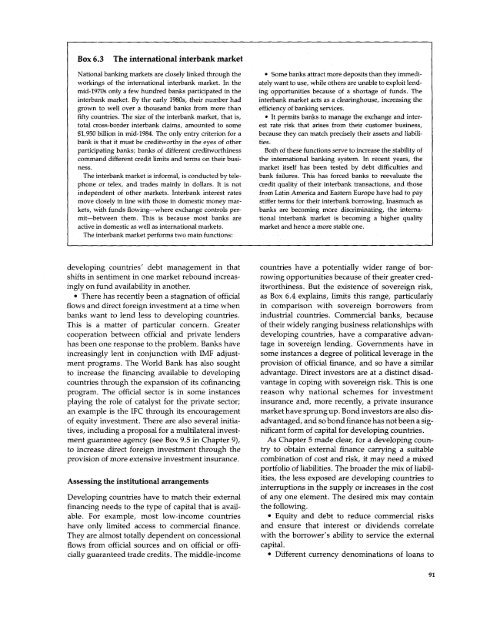World Bank Document
World Bank Document
World Bank Document
Create successful ePaper yourself
Turn your PDF publications into a flip-book with our unique Google optimized e-Paper software.
Box 6.3<br />
The international interbank market<br />
National banking markets are closely linked through the * Some banks attract more deposits than they immediworkings<br />
of the international interbank market. In the ately want to use, while others are unable to exploit lendmid-1970s<br />
only a few hundred banks participated in the ing opportunities because of a shortage of funds. The<br />
interbank market. By the early 1980s, their number had interbank market acts as a clearinghouse, increasing the<br />
grown to well over a thousand banks from more than efficiency of banking services.<br />
fifty countries. The size of the interbank market, that is, * It permits banks to manage the exchange and intertotal<br />
cross-border interbank claims, amounted to some est rate risk that arises from their customer business,<br />
$1,950 billion in rnid-1984. The only entry criterion for a because they can match precisely their assets and liabilibank<br />
is that it must be creditworthy in the eyes of other ties.<br />
participating banks; banks of different creditworthiness Both of these functions serve to increase the stability of<br />
command different credit limits and terms on their busi- the international banking system. In recent years, the<br />
ness.<br />
market itself has been tested by debt difficulties and<br />
The interbank market is informal, is conducted by tele- bank failures. This has forced banks to reevaluate the<br />
phone or telex, and trades mainly in dollars. It is not credit quality of their interbank transactions, and those<br />
independent of other markets. Interbank interest rates from Latin America and Eastern Europe have had to pay<br />
move closely in line with those in domestic money mar- stiffer terms for their interbank borrowing. Inasmuch as<br />
kets, with funds flowing-where exchange controls per- banks are becoming more discriminating, the internamit-between<br />
them. This is because most banks are tional interbank market is becoming a higher quality<br />
active in domestic as well as international markets.<br />
market and hence a more stable one.<br />
The interbank market performs two main functions:<br />
developing countries' debt management in that countries have a potentially wider range of borshifts<br />
in sentiment in one market rebound increas- rowing opportunities because of their greater credingly<br />
on fund availability in another.<br />
itworthiness. But the existence of sovereign risk,<br />
* There has recently been a stagnation of official as Box 6.4 explains, limits this range, particularly<br />
flows and direct foreign investment at a time when in comparison with sovereign borrowers from<br />
banks want to lend less to developing countries. industrial countries. Commercial banks, because<br />
This is a matter of particular concern. Greater of their widely ranging business relationships with<br />
cooperation between official and private lenders developing countries, have a comparative advanhas<br />
been one response to the problem. <strong>Bank</strong>s have tage in sovereign lending. Governments have in<br />
increasingly lent in conjunction with IMF adjust- some instances a degree of political leverage in the<br />
ment programs. The <strong>World</strong> <strong>Bank</strong> has also sought provision of official finance, and so have a similar<br />
to increase the financing available to developing advantage. Direct investors are at a distinct disadcountries<br />
through the expansion of its cofinancing vantage in coping with sovereign risk. This is one<br />
program. The official sector is in some instances reason why national schemes for investment<br />
playing the role of catalyst for the private sector; insurance and, more recently, a private insurance<br />
an example is the IFC through its encouragement market have sprung up. Bond investors are also disof<br />
equity investment. There are also several initia- advantaged, and so bond finance has not been a sigtives,<br />
including a proposal for a multilateral invest- nificant form of capital for developing countries.<br />
ment guarantee agency (see Box 9.5 in Chapter 9), As Chapter 5 made clear, for a developing counto<br />
increase direct foreign investment through the try to obtain external finance carrying a suitable<br />
provision of more extensive investment insurance. combination of cost and risk, it may need a mixed<br />
portfolio of liabilities. The broader the mix of liabil-<br />
Assessing the institutional arrangements<br />
ities, the less exposed are developing countries to<br />
interruptions in the supply or increases in the cost<br />
Developing countries have to match their external of any one element. The desired mix may contain<br />
financing needs to the type of capital that is avail- the following.<br />
able. For example, most low-income countries * Equity and debt to reduce commercial risks<br />
have only limited access to commercial finance. and ensure that interest or dividends correlate<br />
They are almost totally dependent on concessional with the borrower's ability to service the external<br />
flows from official sources and on official or offi- capital.<br />
cially guaranteed trade credits. The middle-income * Different currency denominations of loans to<br />
91

















